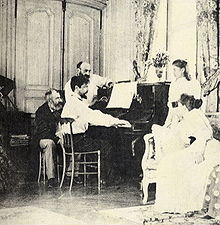Le petit nègre
Le petit nègre ( The Little Negro , also English The Little Negro ) is a well-known piano piece by the French composer Claude Debussy (1862–1918). He composed it in 1909 under the title The Little Nigar for a piano school and published it in the same year. It was later also released individually.
history
Le petit nègre is a late, occasional work by Debussy. He composed it in 1909 for a piano school by Théodore Lack and published it in the music publisher A. Leduc . The piece, written in the key of C major , is influenced by the American Minstrelsy . In the 19th century, this was a form of show in which whites dressed up as blacks and entertained the (white) audience with songs, often in ragtime rhythm, dances such as cakewalk and comedy performances. Even Le petit nègre begins as Ragtime, similar Golliwogg's Cakewalk from Debussy's piano cycle Children's Corner , also providing a parody of Richard Wagner's Tristan und Isolde contains. A lyrical middle section, with a melody tending towards the pentatonic scale, headed espressivo and pianissimo , leads back to the lively opening section after a crescendo .
Debussy also used the theme of the piece in his children's ballet La boîte à joujoux from 1913, where it is introduced by the piccolo and characterizes an English soldier. The piano version of Le petit nègre has also been instrumented in different versions .
Individual evidence
- ^ Andreas Eichhorn: Kurt Weill and France. Waxmann Verlag, 2014. p. 46 ( limited preview in Google book search)
literature
- Lindy Smith: Out of Africa: The Cakewalk in Twentieth-Century French Concert Music. In: Nota Bene. Canadian Undergraduate Journal of Musicology. Vol. 1, Vol. 1, 2008 ( online information ).
Web links
- The Little Nigar (Debussy, Claude) : Sheet music and audio files in the International Music Score Library Project .
- Le petit nègre. In: Jochen Scheytt: The German Debussy pages. 2016.
- N is for Negre - Debussy's Le Petit Negre.
